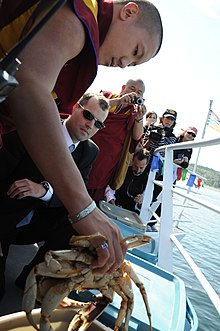Life release

| Part of a series on |
| Buddhism |
|---|
 |
Life release, also known as merit release, mercy release, fangsheng (from Mandarin Chinese 放生) or prayer animal release, is a Buddhist practise of releasing animals held captive with the presumed intention of saving their lives, if they were destined for slaughter, or of giving them back their freedom, as animals nowadays are commonly sold with the explicit purpose to be released for making merit, along with gaining personal merit, or good luck, by performing the act.[1] This practise is performed by all schools of Buddhism: Theravada, Mahayana and Vajrayana.[2] It is known as "Tsethar" in Tibetan Buddhism.[3]
With the popularization of environmental protection knowledge in modern times, researchers and some members of religious communities have started to realize that improper life release can damage the ecological environment, cause Invasive species, and lead to the death of released animals that do not adapt to the environment. In order to avoid the harm of improper life release, Buddhist advocate that vegetarianism is the best way of releasing life from the mouth.[4]
History[edit]
Life release has been practised at least since the 3rd century.[5][6] It is assumed to have been a Taoist or an indigenous Chinese cultural practice according to the first record of the practice in the 3rd century CE, before being adopted by Chinese Buddhists in the 4th or 5th century CE. It subsequently took root in Tibet, Japan, Korea, Sri Lanka, Thailand, Cambodia, Vietnam, Myanmar and Taiwan.[6] It has been performed in Japan since 676, where it is called Hōjō-e.[7]
While this practise of life release may naturally need to be spontaneous to successfully save an endangered life, life release can also be planned. Planning often involves purchasing an animal directly from a slaughterhouse or a fishermen; this can often take place on auspicious days in the Buddhist calendar in order for the merit of the act to be multiplied thousands of times.[2] Animals are blessed before being safely returned to their natural environment as prayers are made and often dedicated to someone who is ill or has died, with the belief that person will benefit too from this dedication.[8]
In Tibet an animal is often marked by a ribbon to indicate that the life of the animal has been liberated, with the general understanding that it will be allowed to die of natural causes.[9] The practise in Tibetan Buddhism has been championed in recent times by Chatral Rinpoche, Dilgo Khyentse Yangsi Rinpoche and Ogyen Trinley Dorje. Although this is seen to be the traditional way of carrying out this practise, Ogyen Trinley Dorje has commented that the meaning is broad and that people can use their intelligence to expand the practise in other ways; indicating that planting one tree may be more beneficial that carrying out Tsethar for many beings.[3]
Today, life release involves many types of animal, including birds, reptiles, fish, and mammals, and involves hundreds of millions of individual animals each year.[5]
Criticism[edit]
It is increasingly recognized that animal release has the potential for negative environmental impacts, including as a pathway for the introduction of invasive species into non-native environments. This may lead to biodiversity loss over time.[6][10] For example, competition from American red-eared slider turtles released in China's lakes has been reported to cause death of native turtles.
Further, some animals are captured for the explicit purpose of being released, or are released into environments where they are unable to survive.[10][11]
Two Buddhists that released hundreds of non-native crustaceans off the English coast in 2015 were fined more than £28,000 for violating the Wildlife and Countryside Act 1981, with the Marine Management Organisation placing bounties on the crustaceans released.[5]

See also[edit]
- Dhammika Sutta
- Dīghajāṇu Sutta
- Five precepts
- Merit release
- Sigālovāda Sutta
- Transfer of merit
- Vessantara Jātaka
References[edit]
- ^ Tsethar - The Practice of Saving Lives
- ^ a b Tsethar for Taklung Tsetrul Rinpoche Archived 2013-04-12 at archive.today
- ^ a b "Life Release". Karma Triyana Dharmachakra. Archived from the original on 2013-12-03.
- ^ "吃素是最好的放生 放生從嘴巴做起".
- ^ a b c Sherwood, Harriet (25 September 2017). "Why Buddhist 'fangsheng' mercy release rituals can be more cruel than kind". The Guardian. Retrieved 30 October 2022.
- ^ a b c Shiu, Henry; Stokes, Leah (2008). "Buddhist Animal Release Practices: Historic, Environmental, Public Health And Economic Concerns". Contemporary Buddhism. 9 (2): 181–196. doi:10.1080/14639940802556529.
- ^ 放生会 Kotobank
- ^ The Buddhist Practice of Releasing Lives to Freedom
- ^ Shambhala Times Community News Magazine » A Yak’s Tale of Liberation
- ^ a b "Mercy Release". Humane Society International.
- ^ Mahavongtrakul, Melalin (7 October 2019). "Human cruelty for a false belief" (Opinion). Bangkok Post. Retrieved 9 October 2019.
External links[edit]
- Releasing birds. Merit or sin? (Video)
